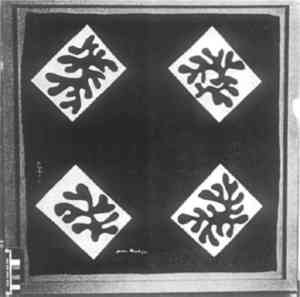THE USE OF SPRAYED POLYVINYL ACETATE RESIN MIXTURES IN THE MOUNTING OF TEXTILESPaul Himmelstein, & Barbara Appelbaum
3 ADDITIONAL EXAMPLESTwo smoothly finished textiles, a nineteenth-century Chinese painted silk fragment, and a printed silk square by Matisse were treated using a similar technique. For the Chinese silk, a piece of cotton fabric was stretched on a temporary strainer and sprayed in much the same way as the crepeline. When a closed-weave fabric is used instead of a net, the spraying is done from a greater distance to form a web of dry adhesive on the surface and avoid impregnating the support fabric. The textile was attached to the cotton using an iron, working through glassine. After attachment, the mounting fabric was transferred to the front of a final strainer, and framed under UF-3 Plexiglas with a conventional ragboard mat. The Matisse textile is in the form of a conventional scarf with rolled and hand-sewn edges. A cotton fabric was sprayed with resins as above, but with a larger proportion of AYAC in the mixture to lower the softening point, and therefore the temperature required for mounting. At the same time, a permanent mounting strainer was prepared as for the flag, with a colored cotton fabric covering the strainer and stretched behind it. The adhesive-sprayed cotton was then stretched behind the colored fabric with the adhesive adjacent to the colored fabric. The scarf was laid in position over the colored fabric, and a pencil mark was made on the front of the colored fabric just inside the rolled edge. The scarf was removed, and the mounting fabric and prepared cotton were sealed together with a tacking iron, around the border up to the pencil line. The colored fabric was cut at the line and the center portion was removed, exposing an area of resin-coated cotton just smaller than the dimensions of the scarf. The scarf was replaced in position and secured with heat. Since the rolled edges
|
